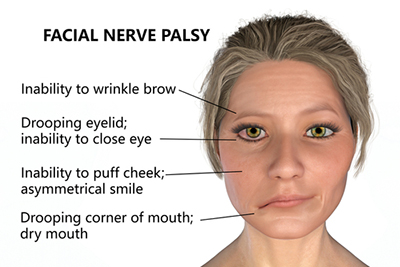Bell's Palsy

Bell's Palsy: Understanding and Managing Facial Paralysis
Bell's Palsy is a condition that causes temporary facial paralysis. Our goal is to educate and guide you on the causes, symptoms, diagnosis, and available treatment options for Bell's Palsy.
1. Introduction
- Definition: Bell's Palsy is a condition characterized by the sudden onset of facial paralysis, usually affecting one side of the face. It occurs due to the inflammation or compression of the facial nerve, which controls the muscles responsible for facial expression.
- Prevalence: Bell's Palsy is estimated to affect approximately 20 to 30 people per 100,000 population per year, making it the most common cause of facial paralysis.
- Impact: The emotional and functional impact of Bell's Palsy can be significant, affecting facial expressions, speech, eating, and overall self-confidence.
2. Causes
- Viral infection: Bell's Palsy is often associated with viral infections, primarily the herpes simplex virus (HSV) or the varicella-zoster virus (VZV).
- Immune system response: Viral infections can trigger an inflammatory response, leading to swelling and compression of the facial nerve.
- Other factors: Other factors that may contribute to the development of Bell's Palsy include genetic predisposition, pregnancy, diabetes, and upper respiratory infections.
3. Symptoms
- Facial paralysis: The hallmark symptom of Bell's Palsy is sudden weakness or paralysis of the muscles on one side of the face. This can make it difficult to close the eye, smile, or make other facial expressions.
- Pain or discomfort: Some individuals may experience mild to moderate pain or discomfort around the jaw or behind the ear on the affected side.
- Altered taste sensation: Changes in the sense of taste, particularly on the front two-thirds of the tongue, may occur due to involvement of the taste fibers within the facial nerve.
4. Diagnosis
- Medical history and physical examination: Our team will take a detailed medical history and perform a thorough physical examination, focusing on assessing facial muscle strength and coordination.
- Imaging tests: In some cases, imaging tests such as magnetic resonance imaging (MRI) or computed tomography (CT) scan may be ordered to rule out other potential causes of facial paralysis.
- Electroneurography (ENoG): This specialized test measures the electrical activity of the facial nerve, helping to determine the severity of nerve damage and predict the potential for recovery.
5. Treatment
- Medications: In most cases, corticosteroids are prescribed to reduce inflammation and promote faster recovery. Antiviral medications may also be prescribed if a viral cause is suspected.
- Physical therapy: Specific facial exercises, massage techniques, and techniques like facial retraining exercises may be recommended to strengthen and retrain the affected facial muscles.
- Eye care: Protecting the affected eye from dryness and injury is crucial. Lubricating eye drops, eye patches, or taping the eyelid closed during sleep may be necessary.
- Supportive care: Ensuring proper rest, stress management, and maintaining a healthy lifestyle are essential in facilitating recovery and reducing the impact of Bell's Palsy.
6. Rehabilitation and Follow-up
- Facial recovery: The recovery timeline for Bell's Palsy varies from person to person. Most individuals experience gradual improvement within weeks to months, with a complete recovery observed in the majority of cases.
- Emotional support: Coping with the emotional and social impact of Bell's Palsy is important. We offer counseling and support to help you manage the emotional challenges associated with facial paralysis.
- Long-term follow-up: In some cases, long-term complications such as facial muscle weakness, synkinesis (involuntary muscle movements), or excessive tearing may require ongoing management and follow-up care.
7. Conclusion
Bell's Palsy can be a distressing condition, but with proper diagnosis, treatment, and support, a significant recovery is achievable. At Dr. Seejo George's practice, we provide compassionate care and comprehensive treatment options tailored to your individual needs. Contact us today to schedule a consultation and begin your journey towards facial recovery and improved quality of life.






